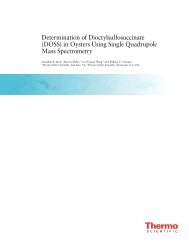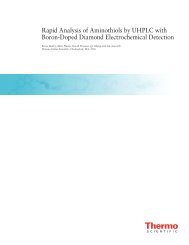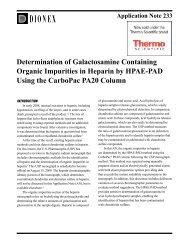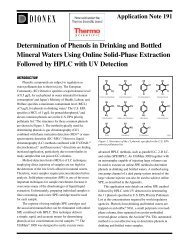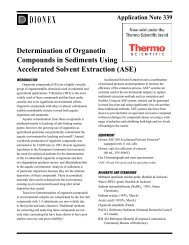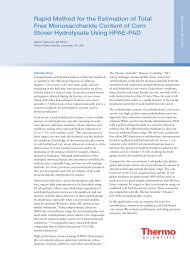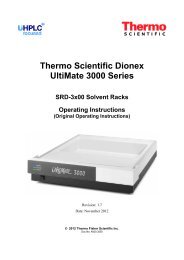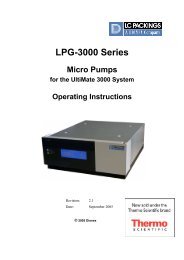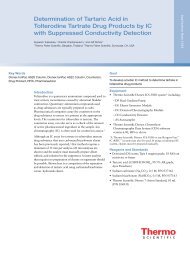AN 195: Determination of Verapamil Hydrochloride Purity ... - Dionex
AN 195: Determination of Verapamil Hydrochloride Purity ... - Dionex
AN 195: Determination of Verapamil Hydrochloride Purity ... - Dionex
You also want an ePaper? Increase the reach of your titles
YUMPU automatically turns print PDFs into web optimized ePapers that Google loves.
Application Note <strong>195</strong><br />
<strong>Determination</strong> <strong>of</strong> <strong>Verapamil</strong> <strong>Hydrochloride</strong><br />
<strong>Purity</strong> Using the Acclaim PA Column<br />
INTRODUCTION<br />
<strong>Verapamil</strong>-based medications are prescribed for<br />
several heart and blood pressure indications. The fastacting<br />
formulations (verapamil hydrochloride and<br />
Isoptin ® ) are taken for angina, as well as irregular<br />
heartbeat and high blood pressure. The United States<br />
Pharmacopeia (USP ® ) has a monograph method to<br />
determine verapamil hydrochloride purity. This method<br />
separates verapamil hydrochloride and verapamil-related<br />
compound B using HPLC with a C18 (USP designation<br />
L1) column. 1 There is a recent proposal to revise the<br />
method by using a L60 column to determine verapamil<br />
hydrochloride and verapamil-related compounds B and<br />
D. The existing method can not determine compound D<br />
under the prescribed eluent. The proposed method is time<br />
consuming (61 min), and requires a special column. 2<br />
In this application note, we describe a new method<br />
for the fast determination <strong>of</strong> verapamil hydrochloride<br />
and verapamil-related compounds A, B, and D, using a<br />
polar-embedded reversed-phase column, the Acclaim ®<br />
PolarAdvantage (PA). The new method requires only<br />
about half the time <strong>of</strong> the proposed USP monograph<br />
method, provides significant eluent and therefore cost<br />
savings, and meets the resolution requirement.<br />
EQUIPMENT<br />
UltiMate ®<br />
3000 HPLC<br />
HPG 3400 pump with SRD 3400 degasser<br />
WPS 3000 TSL autosampler<br />
TCC 3000 thermostatted column compartment<br />
VWD-3400 UV-Vis detector<br />
Chromeleon ®<br />
6.80 SP1 Chromatography Workstation<br />
REAGENTS <strong>AN</strong>D ST<strong>AN</strong>DARDS<br />
Water, Milli-Q water from Milli-Q Gradient A10<br />
Acetonitrile (CH CN), Fisher, HPLC grade<br />
3<br />
KH PO , reagent grade, (AR, analytical pure, grade<br />
2 4<br />
in China)<br />
H PO , reagent grade, (AR, analytical pure, grade<br />
3 4<br />
in China)<br />
<strong>Verapamil</strong> HCl (Sigma, CAS: 152-11-4), purity > 99.0%<br />
<strong>Verapamil</strong>-related compound A (USP, P/N: 71130)<br />
<strong>Verapamil</strong>-related compound B (USP, P/N: 71140)<br />
<strong>Verapamil</strong>-related compound D (LGC Promochem<br />
GmbH, P/N: USP1711428)<br />
Application Note <strong>195</strong> 1
PREPARATION OF REAGENTS <strong>AN</strong>D ST<strong>AN</strong>DARDS<br />
Prepare two solutions for testing, consistent with the<br />
requirements <strong>of</strong> the USP monograph method.<br />
System suitability solution:<br />
Prepare a mixture <strong>of</strong> verapamil hydrochloride,<br />
verapamil-related compound B, and verapamil-related<br />
compound D where each component has a concentration<br />
<strong>of</strong> 25 µg/mL. Add an additional component not described<br />
in the USP method, verapamil-related compound A, also<br />
at 25 µg/mL. Use this solution for method development.<br />
Standard solution and test solution:<br />
Prepare a 2.5 mg/mL standard solution <strong>of</strong> verapamil<br />
hydrochloride. To this solution add the three related<br />
compounds to achieve a final concentration <strong>of</strong> 2.5 µg/mL<br />
each, which serves as the test solution to simulate real<br />
samples.<br />
CHROMATOGRAPHIC CONDITIONS<br />
Column: Acclaim PA, 5 µm, 4.6 × 250 mm<br />
(P/N 061321)<br />
Temperature: 35 °C<br />
Inj. Volume: 5 µL<br />
Mobile Phase: A: 20 mM KH PO adjust pH to 3.0<br />
2 4<br />
with H PO 3 4<br />
B: CH CN 3<br />
Detection: Absorbance at 278 nm<br />
Gradient Table:<br />
Time Flow Rate Buffer (%) CH 3 CN (%) Curve<br />
0.0 1.0 mL/min 70 30<br />
4.0 1.0 mL/min 70 30 5<br />
29.0 1.0 mL/min 45 55 5<br />
29.5 1.0 mL/min 45 55 5<br />
30.0 1.0 mL/min 70 30 5<br />
35.0 1.0 mL/min 70 30 5<br />
2 <strong>Determination</strong> <strong>of</strong> <strong>Verapamil</strong> <strong>Hydrochloride</strong> <strong>Purity</strong><br />
Using the Acclaim PA Column<br />
RESULTS <strong>AN</strong>D DISCUSSION<br />
<strong>Verapamil</strong> (Figure 1) with two aromatic rings is<br />
ideally suited for analysis by reversed-phase HPLC.<br />
Using the proposed USP monograph method as a starting<br />
point, we developed a much faster method that requires<br />
significantly less eluent. Figure 2 shows a separation <strong>of</strong><br />
the system suitability solution described in the proposed<br />
revision to the USP monograph method with an addition<br />
<strong>of</strong> verapamil-related compound A. All four compounds<br />
are well resolved. The resolution <strong>of</strong> verapamil and<br />
verapamil-related compound B is >5.0 as required by the<br />
proposed method and >1.5 as required by the current USP<br />
monograph method.<br />
<strong>Verapamil</strong>-related compound D is eluted, as required<br />
by the proposed USP method. Table 1 shows the repeatability<br />
for retention time and peak areas for five injections<br />
<strong>of</strong> the system suitability standard. The method described<br />
here requires only 35 min compared to the 61 min<br />
required by the proposed USP method. In addition to<br />
the 26 min savings, there is 56.5 mL <strong>of</strong> eluent savings<br />
per injection because the method described here is run at<br />
1.0 mL/min rather than 1.5 mL/min. Chromatography <strong>of</strong><br />
the test solution (Figure 3) shows that this method easily<br />
detects 0.1% quantities <strong>of</strong> verapamil-related compounds<br />
A, B, and D relative to verapamil at 2.5 mg/mL, making it<br />
ideal for verapamil purity analysis.<br />
OCH3<br />
OCH3<br />
CN<br />
Figure 1. Structure <strong>of</strong> verapamil.<br />
N<br />
CH3<br />
OCH3<br />
OCH3<br />
25258
Column: Acclaim ® PA (4.6 x 250 mm)<br />
Eluent: A) 20 mM KH 2PO 4<br />
adjust pH to 3.00 by H 3PO 4<br />
B) Acetonitrile<br />
Gradient: See gradient table.<br />
Temperature: 35 °C<br />
Flow Rate: 1.0 mL/min<br />
18<br />
mAU<br />
–2<br />
0 5<br />
1<br />
2<br />
3<br />
Inj. Volume: 5 µL<br />
Detection: UV (278 nm)<br />
Sample: System Suitability Solution<br />
Peaks: µg/mL<br />
1. <strong>Verapamil</strong> related compound A 25<br />
2. <strong>Verapamil</strong> related compound B 25<br />
3. <strong>Verapamil</strong> HCI RS 25<br />
4. <strong>Verapamil</strong> related compound D 25<br />
Rs=5.13<br />
10 15 20 25 30<br />
Minutes<br />
Figure 2. Overlay <strong>of</strong> five chromatograms <strong>of</strong> the system suitability<br />
solution.<br />
Column: Acclaim ® PA (4.6 x 250 mm)<br />
Eluent: A) 20 mM KH 2PO 4<br />
adjust pH to 3.00 by H 3PO 4<br />
B) Acetonitrile<br />
Gradient: See gradient table.<br />
Temperature: 35 °C<br />
Flow Rate: 1.0 mL/min<br />
350<br />
mAU<br />
1<br />
2<br />
3<br />
Inj. Volume: 5 µL<br />
Detection: UV (278 nm)<br />
Sample: Test Solution<br />
4<br />
35<br />
25259<br />
Peaks:<br />
1. <strong>Verapamil</strong> related compound A 2.5 µg/mL<br />
2. <strong>Verapamil</strong> related compound B 2.5 µg/mL<br />
3. <strong>Verapamil</strong> HCI RS 2.5 mg/mL<br />
4. <strong>Verapamil</strong> related compound D 2.5 µg/mL<br />
–50<br />
0 5 10 15 20 25 30 35<br />
Minutes<br />
25260<br />
4.61<br />
mAU<br />
Figure 3. Chromatogram <strong>of</strong> the test solution.<br />
1<br />
2<br />
–0.82 0.7 10 20 34.9<br />
3<br />
4<br />
4<br />
Table 1. Repeatability <strong>of</strong> Retention Time and Peak Areas<br />
<strong>of</strong> Five Injections <strong>of</strong> the System Suitability Solution<br />
RT (min)/<br />
Area<br />
(mAU•min)<br />
<strong>Verapamil</strong><br />
Related<br />
Compound A<br />
<strong>Verapamil</strong><br />
Related<br />
Compound B<br />
<strong>Verapamil</strong><br />
HCI RS<br />
<strong>Verapamil</strong><br />
Related<br />
Compound D<br />
Injection 1 6.997 1.7798 15.084 15.084 2.0539 16.037 1.2225 2.553<br />
Injection 2 6.991 1.7572 15.083 15.084 2.0654 16.305 1.2338 2.5308<br />
Injection 3 6.99 1.7789 15.082 15.084 2.0771 16.301 1.2186 2.5278<br />
Injection 4 6.989 1.7884 15.075 15.084 2.082 16.295 1.2391 2.54<br />
Injection 5 6.984 1.7802 15.068 15.084 2.0538 16.29 1.228 2.5497<br />
RSD 0.07 0.66 0.04 0.63 0.04 0.67 0.04 0.44<br />
To achieve these improvements over the proposed<br />
USP monograph method, our method uses a polarembedded<br />
reversed-phase column, the Acclaim PA,<br />
rather than an L60. No current L description suitably<br />
describes the resin in the PA column. It previously proved<br />
successful in improving the USP monograph method<br />
for nevirapine, which also prescribes a L60 column. 3 To<br />
shorten run time, achieve the best resolution, and work at<br />
a pH that will ensure the longest possible column life, the<br />
pH <strong>of</strong> the mobile phase is adjusted to 3.0 rather than the<br />
7.2 pH recommended for the L60 column mobile phase.<br />
Application Note <strong>195</strong> 3
Effect <strong>of</strong> mobile phase pH<br />
During method development, testing the effect <strong>of</strong><br />
pH 2.4 to 7.0 showed that lower pH provides higher<br />
resolution <strong>of</strong> verapamil-related compound B and<br />
verapamil. However, pH values lower than 3.1 did<br />
not significantly improve resolution. To meet the USP<br />
resolution requirement (> 5.0), a 250 mm column was<br />
required (same length as the L60). If a 150-mm column<br />
is preferred and a resolution <strong>of</strong> 5.0 between verapamil<br />
and verapamil-related compound B is not required, the<br />
150-mm column will yield a resolution <strong>of</strong> about 4.0.<br />
Figures 4 and 5 show the system suitability and<br />
test solutions analyzed at pH 2.9, 3, and 3.1. The<br />
chromatography shows that the method is rugged when<br />
challenged by small changes in pH.<br />
Column: Acclaim ® PA (4.6 x 250 mm)<br />
Eluent: A) 20 mM KH 2PO 4<br />
adjust pH with H 3PO 4<br />
B) Acetonitrile<br />
Gradient: See gradient table.<br />
Temperature: 35 °C<br />
Flow Rate: 1.0 mL/min<br />
Inj. Volume: 5 µL<br />
Detection: UV (278 nm)<br />
18<br />
mAU<br />
–2<br />
18<br />
mAU<br />
–2<br />
20<br />
mAU<br />
A<br />
B<br />
C<br />
1<br />
2<br />
Sample: System Suitability Solution<br />
Cgrams: A. pH = 3.10<br />
B. pH = 2.87<br />
C. pH = 3.00<br />
Peaks:<br />
1. <strong>Verapamil</strong> related compound A 25 µg/mL<br />
2. <strong>Verapamil</strong> related compound B 25 µg/mL<br />
3. <strong>Verapamil</strong> HCI RS 25 mg/mL<br />
4. <strong>Verapamil</strong> related compound D 25 µg/mL<br />
3<br />
pH=3.0, Rs=5.13<br />
pH=2.87, Rs=5.13<br />
pH=3.10, Rs=5.13<br />
–2<br />
0 5 10 15 20 25 30 35<br />
Minutes<br />
25261<br />
Figure 4. Overlay <strong>of</strong> chromatograms <strong>of</strong> the system suitability solution<br />
analyzed with different pH mobile phases. Peaks: 1) verapamilrelated<br />
compound A; 2) verapamil-related compound B;<br />
3) verapamil HCI RS, 4) verapamil-related compound D.<br />
4 <strong>Determination</strong> <strong>of</strong> <strong>Verapamil</strong> <strong>Hydrochloride</strong> <strong>Purity</strong><br />
Using the Acclaim PA Column<br />
4<br />
Column: Acclaim ® PA (4.6 x 250 mm)<br />
Eluent: A) 20 mM KH 2PO 4<br />
adjust pH with H 3PO 4<br />
B) Acetonitrile<br />
Gradient: See gradient table.<br />
Temperature: 35 °C<br />
Flow Rate: 1.0 mL/min<br />
Inj. Volume: 5 µL<br />
Detection: UV (278 nm)<br />
3.7<br />
mAU<br />
–1.0<br />
3.7<br />
mAU<br />
–1.0<br />
3.7<br />
mAU<br />
A<br />
B<br />
C<br />
1<br />
2<br />
Sample: System Suitability Solution<br />
Cgrams: A. pH = 3.10<br />
B. pH = 2.87<br />
C. pH = 3.00<br />
Peaks:<br />
1. <strong>Verapamil</strong> related compound A 2.5 µg/mL<br />
2. <strong>Verapamil</strong> related compound B 2.5 µg/mL<br />
3. <strong>Verapamil</strong> HCI RS 2.5 mg/mL<br />
4. <strong>Verapamil</strong> related compound D 2.5 µg/mL<br />
3<br />
pH=3.10<br />
pH=2.87<br />
pH=3.00<br />
–1.0<br />
0 5 10 15 20 25 30 35<br />
Minutes<br />
25262<br />
Figure 5. Analysis <strong>of</strong> the test solution with different pH mobile<br />
phases. Peaks: 1) verapamil-related compound A (2.5 µg/mL);<br />
2) verapamil-related compound B (2.5 µg/mL), 3) verapamil HCI<br />
RS (2.5 mg/mL); 4) verapamil-related compound D (2.5 µg/mL).<br />
4
REFERENCES<br />
1. United States Pharmacopeia National Formulary<br />
USP30/NF25 (2007), 3454.<br />
2. Pharmacopeial Forum (2006) 32(2) 389.<br />
3. <strong>Dionex</strong> Application Note 180.<br />
Passion. Power. Productivity.<br />
<strong>Dionex</strong> Corporation<br />
1228 Titan Way<br />
P.O. Box 3603<br />
Sunnyvale, CA<br />
94088-3603<br />
(408) 737-0700<br />
North America<br />
U.S. (847) 295-7500<br />
Canada (905) 844-9650<br />
South America<br />
Brazil (55) 11 3731 5140<br />
Europe<br />
Austria (43) 1 616 51 25 Benelux (31) 20 683 9768 (32) 3 353 4294<br />
Denmark (45) 36 36 90 90 France (33) 1 39 30 01 10 Germany (49) 6126 991 0<br />
Ireland (353) 1 644 0064 Italy (39) 02 51 62 1267 Switzerland (41) 62 205 9966<br />
United Kingdom (44) 1276 691722<br />
Isoptin is a registered trademark <strong>of</strong> Knoll Aktiengesellschaft.<br />
USP is a registered trademark <strong>of</strong> the United States Pharmacopeia.<br />
Acclaim, Chromeleon, and UltiMate are registered trademarks <strong>of</strong> <strong>Dionex</strong> Corporation.<br />
Asia Pacific<br />
Australia (61) 2 9420 5233 China (852) 2428 3282 India (91) 22 2764 2735<br />
Japan (81) 6 6885 1213 Korea (82) 2 2653 2580 Singapore (65) 6289 1190<br />
Taiwan (886) 2 8751 6655 Application Note <strong>195</strong> 5<br />
LPN 2039 PDF 4/08<br />
www.dionex.com<br />
©2008 <strong>Dionex</strong> Corporation




